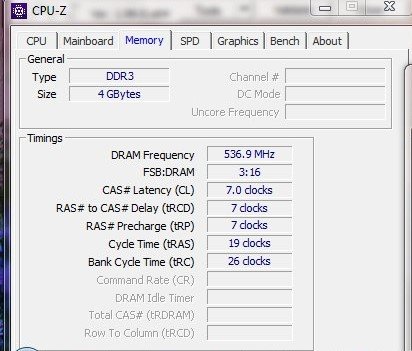Comparing: DDR3 1066MHz SODIMM vs LPDDR5 4800MHz
In this comparison, we analyze two Memory: DDR3 1066MHz SODIMM and LPDDR5 4800MHz, using synthetic benchmark tests to evaluate their overall performance. This side-by-side comparison helps users understand which hardware delivers better value, speed, and efficiency based on standardized testing. Whether you're building a new system or upgrading an existing one, this benchmark-driven evaluation offers valuable insights to guide your decision.

DDR3 1066MHz SODIMM
| Type: | Memory |
|---|---|
| Model: | DDR3 1066MHz SODIMM |
| Freq: | 1066MHz |
Specification Comparison Table
This specification comparison presents technical details of several devices or components to help you understand the key differences between each option. Use this table as a reference to determine which device best suits your needs.
| Specification | DDR3 1066MHz SODIMM | LPDDR5 4800MHz |
|---|---|---|
| Model | DDR3 1066MHz SODIMM | LPDDR5 4800MHz |
| Frequency | 1066MHz | 4800 MHz |
Submission Comparison Table
This submission comparison table displays the number and details of benchmark data submissions from various devices or components. This information helps you understand the performance based on the benchmarks that have been tested, as well as providing an overview of the consistency and popularity of the available benchmark results.
| No. | Benchmark Software | DDR3 1066MHz SODIMM | LPDDR5 4800MHz |
|---|---|---|---|
| 1 | PYPrime - 2B with BenchMate |
2min, 3sec, 3ms |
14sec, 377ms |
| 2 | AIDA64 - Memory Read |
5529 points |
49727 points |
Submission Comparison Chart
This chart visualizes the benchmark scores comparison between two hardware devices based on submitted data.
Media Gallery
A collection of photos of tested hardware. These images can help you identify the physical form, model, and variant of the hardware in question. These photos are from our own documentation, and if they are not available we may not be able to document them.
About Hardware DDR3 1066MHz SODIMM
DDR3 1066MHz SODIMM is a type of low-medium speed RAM that is still widely used in older generation laptops or devices with limited specifications. With the SODIMM (Small Outline Dual In-line Memory Module) form factor, this module is specifically designed for compact devices such as notebooks and mini PCs. The configuration in this test uses two pieces of RAM from different brands, ADATA and Micron, each with a capacity of 2GB, bringing the total memory to 4GB in single-channel mode.
Although the RAM modules have a native frequency of 1600MHz, the system sets the speed limit to 1066MHz due to the limitations of the AMD E1-1200 processor used in the HP 1000 1b05AU laptop. This is a clear example of how RAM speed also depends on CPU and motherboard architecture support. The memory timings were recorded at 7-7-7-19, which indicates a fairly tight latency configuration for the entry-level DDR3 class, providing a balance between stability and efficiency.
Tests were conducted in Windows 7 and Windows 8 operating systems, which are quite common on devices with these specifications. Based on synthetic performance testing using PYPrime 2B (via BenchMate), the completion time was recorded at 2 minutes 3 seconds 3 milliseconds, reflecting the system's capability in handling light to medium computing workloads. Meanwhile, a benchmark using AIDA64 showed a Memory Read score of 5529 points, which is quite good for this class of frequency-limited DDR3 RAM.
Overall, this combination of DDR3 1066MHz SODIMMs with a total capacity of 4GB is still reliable for running light operating systems, browsing, and other basic computing tasks on older generation laptops. While it can't match the performance of a modern DDR4 or DDR5, this RAM is still relevant for users who want to revive an older laptop for light use or simply as a backup device. With its affordable price and wide availability in the market, DDR3 SODIMM is a great choice for a cost-effective and functional upgrade.
Device test (testbed)
Device: HP 1000 1b05au
CPU: AMD E1-1200
RAM: 2x2GB Single Channel (limit from CPU)
OS: Windows 7, Windows 8
Wednesday, 12 December 2012 14:27:27 | Update: 1 month ago
About Hardware LPDDR5 4800MHz
The 4800MHz LPDDR5 module embedded in the Acer Aspire 5 A515-58P is a next-generation memory solution specifically designed to deliver high speed and maximum power efficiency in modern devices such as ultrabooks and thin laptops. It uses Micron-made chips with a total capacity of 8GB embedded directly into the motherboard (onboard), making it non-upgradable yet more space and energy efficient than conventional SODIMM modules. Running at a frequency of 4800MT/s and timings of CL52-44-44-104 1T, this LPDDR5 offers extremely low latency and much higher memory bandwidth compared to previous generations such as LPDDR4X.
In performance testing, this memory showed very impressive results for the thin laptop class. In the PYPrime 2B benchmark with BenchMate, the time recorded was only 14 seconds 377 milliseconds, indicating a very solid CPU and RAM performance in processing heavy computing loads based on integer calculations. Meanwhile, testing using AIDA64 Memory Read showed a reading of 49,727 points, proving that Micron's 4800MHz LPDDR5 is capable of delivering high memory read speeds, which greatly supports the smooth multitasking, productivity and media consumption needs of the Windows 11 22H2 operating system.
With its combination of high power efficiency, excellent data transfer speed, and direct device integration, LPDDR5 4800MHz is the ideal choice for modern laptop users who prioritize responsiveness and battery life without compromising on performance.
Device test (testbed):
Device: Acer Aspire 5 A515-58P
CPU: i5 1335U
RAM: 8GB LPDDR5 (Fix, Cannot Upgrade)
OS: Windows 11 22H2
Tuesday, 15 August 2023 13:16:48 | Update: 1 month ago


